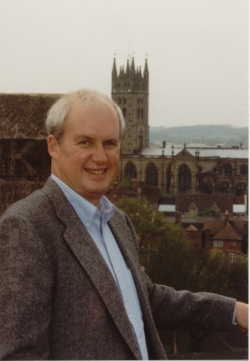 For today’s interview, I’m extremely proud to introduce one of my favorite writers and a true legend of speculative fiction: L.E. Modesitt Jr., author of over fifty fantasy and science fiction novels! During my long conversation with Mr. Modesitt, we touched on a wide range of topics, covering the author’s overall career and of course his current fantasy series, The Imager Portfolio. I even persuaded him to recommend a handful of novels for people who may be daunted by the sheer size of his bibliography!
For today’s interview, I’m extremely proud to introduce one of my favorite writers and a true legend of speculative fiction: L.E. Modesitt Jr., author of over fifty fantasy and science fiction novels! During my long conversation with Mr. Modesitt, we touched on a wide range of topics, covering the author’s overall career and of course his current fantasy series, The Imager Portfolio. I even persuaded him to recommend a handful of novels for people who may be daunted by the sheer size of his bibliography!
This ended up being a long interview – well over 4,000 words – so take a moment and get settled in before you start reading!
Please note: the newest novel in L.E. Modesitt Jr.’s Imager Portfolio, Princeps, was released today, May 22nd. My review is up at Tor.com and will appear here next week. In a day or two, I’ll also have a giveaway, courtesy of the kind people at Tor. The giveaway will go up right here at Far Beyond Reality, so make sure to bookmark, favorite, subscribe, add to your RSS, or do whatever else you need to do to stay tuned…
Far Beyond Reality: Your new novel Princeps and its predecessor Scholar are set several hundred years before the first three novels in the Imager Portfolio. You’ve followed a similar pattern in the Corean Chronicles and of course the Saga of Recluce. What motivated you to start exploring different eras of your fantasy universes? What’s your process when you create the timelines, and how much of each world’s history do you know when you start a new series?
L.E. Modesitt Jr.: I was actually interested in history, especially ancient history, long before I became a poet, and certainly long before I started writing science fiction and fantasy. I always wondered about how the present might have changed had history been different, and I was always curious about how the past led to the present. That interest remained even when I started writing science fiction and then fantasy, and I’ve had at least a basic past history in my mind for every book I’ve ever written. I put historical references in every book, to a greater or lesser degree depending on the book, even in books that I think are likely to be stand-alone novels. Sometimes the timelines are not pinned down to the exact year, but to critical events, although I have made a concrete timeline available for the Saga of Recluce. I don’t know that I have a formal “process” for creating a timeline. It’s more of a series of questions, beginning with, “How did this culture come to be?” As for how much of the history I know before I start to write, that varies from series to series, but I have to admit that I do add to that history as I write more in a series. I obviously know much more of the history for my science fiction books because every one I’ve written has its history rooted in the past, present, and projected future of Earth.
 Far Beyond Reality: This sense of historical detail adds a certain degree of realism to your fiction that’s quite unique in fantasy and SF. Another aspect of your writing that does this is your habit of showing what the daily life of your characters is like, including frequent and detailed descriptions of their meals, living environments, daily routines, and so on. Is realism something you aim for in your writing?
Far Beyond Reality: This sense of historical detail adds a certain degree of realism to your fiction that’s quite unique in fantasy and SF. Another aspect of your writing that does this is your habit of showing what the daily life of your characters is like, including frequent and detailed descriptions of their meals, living environments, daily routines, and so on. Is realism something you aim for in your writing?
L.E. Modesitt Jr.: For better or worse, I do stress a certain amount of realism in my writing. Certain aspects of that realism have been especially noted, such as my interest in food and meals, but part of that emphasis in my novels comes from another aspect of reality. In most non-high-technology societies, and even in our society, meals are usually where people talk about what they’ve done, what they plan, and how they feel. My depiction of parts of daily life is because I’d like to convey the idea that my heroes and heroines and those other protagonists who are not properly either do in fact have “everyday” lives, and also that people who live everyday lives can face difficult challenges and surmount them, if at a price. At times, they can achieve their dreams, but the price for achieving those dreams is in fact realistic – it costs most of them more than they ever considered they’d have to pay, although sometimes the cost is that others that they love and care for pay a share of that price as well… which is realistic, but not always considered in fiction. In fact, “great achievements” throughout history have usually exacted a price on others as well as on the “achiever,” although I’ve noted that in fiction all too often only the achievements of the antagonist are paid by others, and less often are the costs of the protagonist’s achievements placed on others as well.
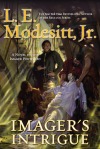
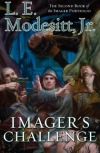
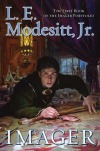 Far Beyond Reality: Is that one of the reasons why you emphasized family as a theme in the first three Imager books? Rhenn’s parents and siblings are directly affected by the repercussions of his actions, as is his own young family and his wife’s extended family. Quaeryt, by contrast, is more of a loner: he’s an orphan and enters an arranged marriage. Why the big contrast between Rhenn and Quaeryt in terms of family connections? And will we ever learn more about Quaeryt’s parents?
Far Beyond Reality: Is that one of the reasons why you emphasized family as a theme in the first three Imager books? Rhenn’s parents and siblings are directly affected by the repercussions of his actions, as is his own young family and his wife’s extended family. Quaeryt, by contrast, is more of a loner: he’s an orphan and enters an arranged marriage. Why the big contrast between Rhenn and Quaeryt in terms of family connections? And will we ever learn more about Quaeryt’s parents?
L.E. Modesitt Jr.: I wanted to portray Rhenn as a warm and moderately sensitive young man who, in order to survive, is forced over the course of the first three books by the interaction of circumstances and his own abilities to acts he never would have considered at the beginning of Imager. In a sense, he has to transcend the limitations of family in order to save his land, and the imagers, and his family pays part of that price. The subpoint, of course, is that his brother Rousel, while warm and generous, is also flawed, and when the pressures on Rhenn and his family build, the breaking point occurs where the flaw is. In a larger sense, the first three books show the personal costs of greatness, but they also show to what lengths a man will go to protect his family, because, while it’s never stated explicitly, Rhenn knows that Seliora and his daughter will never be safe until the source of the attacks on him and them is removed.
I’d like to say that the contrast between Rhenn and Quaeryt was planned, but I developed Quaeryt far more out of a gut sense of who he was and had to be than from a cold rational plan. Rhenn is an insider in terms of family and culture, but an outsider to the imagers because he comes to imaging late. Quaeryt is a total outsider who has learned and continues to learn what it’s like on the inside, so to speak, but he remains an emotional step removed from Bhayar, the court, its ministers and officials, and the officers with whom he serves. Vaelora also is a step removed emotionally, if for very different reasons, and that degree of removal is one of the ties that binds them. It also allows them greater freedom of action in some ways, but also limits them because others understand instinctually that Quaeryt and Vaelora are different in a subtle but fundamental way, and those others watch every step either of the two takes.
As the five books about Quaeryt progress, readers will learn more and more about Quaeryt’s background and heritage and how those bear on his actions, and the costs that heritage brings with it.
Far Beyond Reality: Many of your protagonists share several qualities. They’re often rational, even cerebral people. They tend to be observant and reserved, but not afraid to take action and speak up when necessary. They often go through a growth curve in terms of their influence and, concurrently, their various skills or powers. Even though they have individual differences, the similarities are noticeable. Why does this type of character so frequently take the lead role in your novels?
L.E. Modesitt Jr.: That’s an interesting take on my characters, because I wouldn’t characterize them as either rational or cerebral, but more as thoughtfully intuitive. A number of them act long before those who are “rational” would dare to take a first step. They’re generally not people who wait for all the evidence to arrive. More than one of them has observed that if you wait for all the evidence to arrive, you’ll be dead or defeated. Many of them worry about that very trait, and some of them have suffered in the short run for seeming to be too impulsive. I probably write about such characters precisely because there are too few people with such traits in real life. The majority of people tend to be either reactive, passive players, or short-term schemers, and very few see their acts as part of a larger scheme. A smaller minority wants conclusive evidence before doing anything at all. I definitely have a tendency to write about people with goals and desires larger than themselves, particularly in terms of how they acquire and use power, and I likely do so because after working twenty years in and around national politics in Washington, D.C., it became all too clear that the greatest corruption of all was that those who sought power for change seldom accomplished what they might have because they became intoxicated by power and position and eventually refused to spend power to accomplish change, which is always necessary.
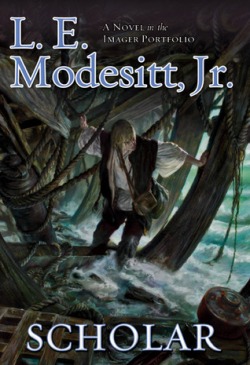 Far Beyond Reality: What I meant by rational is that your characters rarely seem driven by emotion or self-interest. Before taking action, they often consider the best course of action almost like an equation, aiming for the best possible outcome and for the “greater good.” But your point is well taken: they’re not afraid to act quickly when needed, and Quaryt is a great example of this in Scholar and Princeps. Going back to what you just said about your time in Washington: are there other ways in which your experience in the political world influenced you as an author?
Far Beyond Reality: What I meant by rational is that your characters rarely seem driven by emotion or self-interest. Before taking action, they often consider the best course of action almost like an equation, aiming for the best possible outcome and for the “greater good.” But your point is well taken: they’re not afraid to act quickly when needed, and Quaryt is a great example of this in Scholar and Princeps. Going back to what you just said about your time in Washington: are there other ways in which your experience in the political world influenced you as an author?
L.E. Modesitt Jr.: Given who my characters are and the situations in which they find themselves, often the only solution that will serve their self-interest is one that serves others as well. That is one of the aspects of politics that I found most intriguing – that so few of today’s politicians seem to recognize that such situations do exist, or, if they do, find themselves unable to take advantage of win-win situations. Part of that problem is because running for election is so expensive, and seldom do the immediate interests of those who have money coincide with longer term and optimal solutions. This conflict is mirrored in the power shifts taking place in Solidar in Imager’s Intrigue, where the land-holding and often land-poor High Holders don’t want to support policies that will strengthen Solidar because such policies will weaken them and improve the position of the “industrial” High Holders and the factors. Another thing I learned in Washington is that being accurate in being able to predict what will happen is often totally useless and sometimes politically fatal, and almost always results in anyone who outlines a predictable and sometimes inevitable, but unpopular, outcome being marginalized or ignored, if not both. There’s a small example of this in Imager’s Intrigue, dealing with the provision for Council representation based on the number of High Holders. Readers will see another illustration of this in a forthcoming book The One-Eyed Man. In the end, my experiences in Washington greatly strengthened my desire to leave it and become a full-time author.
Far Beyond Reality: I’ve tried to cover a few things I consider unique about your works: your habit of exploring different eras of your fantasy universes, the level of detail in your fiction, the shared characteristics of many of your protagonists. What have I missed? What would you say is unique about your work?
L.E. Modesitt Jr.: In a phrase — the unobviousness of the obvious. My work almost always points out or shows by example something that underlies society or culture or science – something basic that has seldom, if ever, been noticed for what it is – that is so obvious that, once it is pointed out, critics and others way, “Oh… that’s so obvious.” One clear example is the reversal of colors associated with morality in the Saga of Recluce. In the opening books, the “good guys” are the blacks, and the evil ones are the whites. Later on, I show that the whites can have their good guys as well. The point behind this was to show that such moral/color equations are not universal, no matter how much we think they are, but culture-centric. White is not the color of purity in many far eastern cultures, but the color of death. Brides wear red rather than white in many Asian cultures. The “holy” color in India is that orange-saffron. The Spellsong Cycle explores the issue of power by making vocal music the heart of magic – and shows why something that is universal [singing] and should theoretically be a widespread source of power cannot be, because true singing is not what people think it is (nor is it as easy as anyone thinks, except for trained singers). Of course, some readers still didn’t get it. Archform:Beauty takes on the issues of beauty, and also offers a tidbit on the significance of the change in meaning of the word “discrimination” over the past generation, a change that is absolutely obvious, and totally ignored. In The Octagonal Raven, I took on the dangers of a talent-based meritocracy, something we’re seeing today in the United States, although I pointed them out over a decade ago. Now, I have to admit that I’m not original in noting this. The British philosopher Alfred North-Whitehead observed a century ago that if one wishes to understand a society, one should look at the fundamental assumptions underlying that society, the assumptions so obvious that no one has ever questioned them. In a quiet way, that’s what I try to do when I can.
 Far Beyond Reality: You’ve been an incredibly prolific author from the start of your career. Not a year goes by that we don’t see at least one novel by you, sometimes two. What’s your daily work routine like? How do you manage to keep producing such an amazing stream of novels?
Far Beyond Reality: You’ve been an incredibly prolific author from the start of your career. Not a year goes by that we don’t see at least one novel by you, sometimes two. What’s your daily work routine like? How do you manage to keep producing such an amazing stream of novels?
L.E. Modesitt Jr.: Actually, I’ve averaged writing and publishing roughly 2 ½ books a year since I became a full-time writer in 1993. Prior to that, when I was holding down a full-time job (or two half-time jobs between 1990 and 1993), I only managed about one book a year. There are a number of reasons why I’ve been able to write as much as I have. First… I have no hobbies, and I’m not, as my wife puts it, a “toy boy” who’s interested in gimmicks or gadgets or technology for the sake of technology. Second, I generally watch very little television and never have. Third, I’m a very fast reader, which makes research and checking background material easier and quicker. Third, I’d rather write than “play,” or perhaps writing is my play. As for my daily routine, it’s fairly boring, and that’s fine. In the years after college until I finally left Washington, D.C., I had more than enough excitement. On most days, I get up, give the dogs a quick walk, feed them while I’m fixing breakfast, eat breakfast, take a brisk 2-2 ½ mile walk with the energetic Aussie-Saluki, shower, dress, and sit down to write. I write anywhere from nine or ten in the morning until from seven to ten in the evening, mixing in shopping, laundry, fixing meals, and other domestic chores (because I’m now the stay-at-home spouse), and most weeks I do this six days a week. I usually take half of Saturday or Sunday off, depending on my wife’s work schedule. Not all the writing is fiction, of course, because I’m also writing 1,000 – 1,500 words a week for the website blog.
Far Beyond Reality: Aside from becoming a full-time writer, how do you feel you’ve changed as an author since you started out?
L.E. Modesitt Jr.: Asking anyone, particularly an author, to assess how they’ve changed may not get you the most accurate answer because we all wish to present the best side of ourselves… but you did ask. I don’t think the “technical” aspects of my writing, the grammar, the ability to frame sentences or describe things, etc., has changed much, although how I use that technical skill has. My writing has definitely improved, because I understand how to write a story better now than I did 40 years ago when I wrote and sold my first S.F. story – almost exactly 40 years ago, now that I think of it. But writers change as their lives alter, and I’ve definitely changed as a person. I was far more openly enthusiastic and idealistic – anyone who enters politics as a junior staffer is either idealistic or opportunistic, if not both. I was merely idealistic and desperate, having been less than successful as an industrial economist and as a real estate agent. Today, I’m rather more cynical than I was forty years ago, if in the sense that I’ve stated more than once – cynicism is often the last refuge of the idealist. That’s reflected to some degree, if not more, in my characters and their actions. They know that, whatever they do, if they’re to accomplish something, someone is going to get hurt. Also, I have very few traditional “villains,” because evil has its own intelligence and reasons, and often your “good” is what I see as evil, especially when dealing with political and religious extremes.
Far Beyond Reality: I was lucky enough to discover your work when you only had about two dozen novels out. By now that number has more than doubled. The sheer size of your bibliography may be daunting for newcomers. If you were to recommend three of your books for someone who has never read anything by you, which ones would you choose and why?
L.E. Modesitt Jr.: The problem with picking three books is that, no matter what I pick, merely zeroing in on three books leaves out too many, more so on the science fiction side than on the fantasy side. Given the reactions so far, the fantasy book I’d suggest would be Imager, the opening volume of The Imager Portfolio, which most of my long-time readers have greatly enjoyed. From the SF side, for starters, I’d suggest The Eternity Artifact, because it not only sold well, but also was named a best book of the year by Kirkus. After those two, it gets harder, because many people have greatly enjoyed The Magic of Recluce, the opening volume of the Recluce Saga, which remains, so far, the most popular of my series, with sixteen books so far – but with no more than two about any one set of characters, spread across five continents and nearly 2,000 years. But what about Of Tangible Ghosts, the first of my alternate history, semi-thriller, semi-mystery, ghosts-are-real series, also available in a two for one trade paperback (Ghosts of Columbia)? Or The Parafaith War… or The Forever Hero…? All right… I’ll stop at six, or is it seven, but… every single book I’ve written has readers who think that particular book is the best one I’ve written, and that makes it hard to pick out a book that appeals to a general audience. When readers ask me what book I’d recommend, I generally ask them what else they like from other authors, and then suggest one close to what they’ve read and enjoyed.
Far Beyond Reality: That highlights something else that stands out about your career: in addition to being one of the most prolific authors around, you’re also one of the few who regularly and successfully writes both science fiction and fantasy. Do you have a different approach or method when you’re writing in each genre? And, even though I realize this is another “Sophie’s Choice” question like the last one, do you have any kind of preference for one of them?
L.E. Modesitt Jr.: I don’t have different methods for writing science fiction and fantasy. I use the same basic approach to each, but what I’d call the informational assumptions are different. For example, our world is, so far, best described by the standard model of physics, and I use those laws, if sometimes creatively, as the underlying world structure for my science fiction. In writing fantasy, since magic defines the underlying world structure, I apply a logical magic system. In the Saga of Recluce, that is defined by the interplay between order and chaos, and there’s a rigid model for that (which I described in an article for Black Gate several years ago), based partly on standard physics and string theory, not that a word of either ever appears in a Recluce novel. In the Spellsong Cycle, magic is based on the technical application of music. The magic of the Corean Chronicles rests on an adaptation of the Gaian concept of a planetary life-force web. And, of course, the imaging of The Imager Portfolio rests on a method of mental visualization – with appropriate energy balances and costs. This approach has, in the past, caused some to claim that I don’t write fantasy at all, but science fiction disguised as fantasy. I’d counter that by suggesting the implications of such criticism would result in a definition of fantasy that could only include totally illogical and irrational magic, and while I don’t have a problem with that kind of magic in fantasy, I’d say that fantasy is and should be more than about the irrational in magic.
My science fiction does tend to be more complex than my fantasy and perhaps, in most cases, a bit darker, although often that darkness isn’t all that obvious on first reading.
I can’t say that I have a preference for writing one or the other, because I can do some things in each genre that I can’t in the other, and, no, I’m not about to explain most of them, but one that’s obvious is that I can write stand-alone books in SF, which tends to be impractical in fantasy, unless you’re writing urban fantasy or one or two specific sub-genres that don’t interest me.
Far Beyond Reality: Are there any authors you would consider influences on your work and career? And, more recently, are there any current authors you admire?
L.E. Modesitt Jr.: To some degree, every author I’ve ever read has influenced my work, if mostly subconsciously, I suspect. Overall, my favorite remains William Butler Yeats, although I still re-read T.S. Eliot, Wallace Stevens, and W. H. Auden. In the F&SF field, certainly A.E. Van Vogt was an early influence, as were the Barsoom books of Edgar Rice Burroughs. More “contemporary” but older authors that I’ve admired include Roger Zelazny, Fred Saberhagen, Sheri Tepper, Gordon Dickson, Ann McCaffrey, Alfred Bester, Michael Moorcock, and Ursula K. LeGuin. Of the current crop of writers in the field, I’ve appreciated the work of Jack McDevitt, Alastair Reynolds, Louise Marley, Mary Robinette Kowal, Sharon Shinn, and Tim Powers. I won’t claim that those names are exclusive, but the ones that come to mind at the moment.
Far Beyond Reality: My final questions are about your upcoming works. I saw on your site that you have a standalone SF novel coming up soon: The One-Eyed Man. I’ve mentioned many times in my reviews that I’m a big fan of your SF, so I’m very excited about this novel. Can you tell us a bit about it?
 L.E. Modesitt Jr.: In fact, it’s a novel I never intended to write… or more precisely, it started out as a short story intended for David Hartwell’s Palencar Project. After I’d written more than 11,000 words I realized that it wasn’t a short story at all, but the beginning and various pieces – since I don’t always write in story or chronological order when I’m creating something – of a novel. I set it aside and then wrote the short story for the Palencar Project that was published on Tor.com (“New World Blues”). Then I wrote Imager’s Battalion and Antiagon Fire. After I finished Antiagon Fire and sent it off to David for his comments and edits, I took a break from The Imager Portfolio and finished the novel that became The One-Eyed Man. Like all the stories in the Palencar Project, the book is based on the painting by John Jude Palencar, and there has been some consideration of using that painting as the cover illustration, but whether that will happen is up to the editors and the art director. And yes, the book is science fiction, fairly hard SF at that, with a techno-environmental twist amid political and corporate maneuvering… and it’s very unlike any of the Palencar Project stories, including mine.
L.E. Modesitt Jr.: In fact, it’s a novel I never intended to write… or more precisely, it started out as a short story intended for David Hartwell’s Palencar Project. After I’d written more than 11,000 words I realized that it wasn’t a short story at all, but the beginning and various pieces – since I don’t always write in story or chronological order when I’m creating something – of a novel. I set it aside and then wrote the short story for the Palencar Project that was published on Tor.com (“New World Blues”). Then I wrote Imager’s Battalion and Antiagon Fire. After I finished Antiagon Fire and sent it off to David for his comments and edits, I took a break from The Imager Portfolio and finished the novel that became The One-Eyed Man. Like all the stories in the Palencar Project, the book is based on the painting by John Jude Palencar, and there has been some consideration of using that painting as the cover illustration, but whether that will happen is up to the editors and the art director. And yes, the book is science fiction, fairly hard SF at that, with a techno-environmental twist amid political and corporate maneuvering… and it’s very unlike any of the Palencar Project stories, including mine.
Far Beyond Reality: Can you give us a hint of what’s in store for Quaeryt in the final volumes of the Imager Portfolio? And, staying in that part of the Imager timeline, will we ever read the story of the last Tilboran Khanara, Tyrena? There’s a hint in Scholar that she may have married into the family of High Holder Ryel, who played such a big role in the first three Imager novels, so I’m curious whether she may be the topic of a future novel?
L.E. Modesitt Jr.: After Princeps, there are three more novels about Quaeryt – Imager’s Battalion, Antiagon Fire, and the last one, tentatively entitled Rex Regis. I think it’s fair to say that Quaeryt ends up, more than once, biting off almost more than he can chew, especially as matters between Bovaria and Telaryn boil over, and… the same goes for Vaelora. With the next two books, matters continue to escalate overtly, while in the last book, the escalation includes more intrigue and political maneuvering, as well as a new phase in imaging, not to mention hefty prices to be paid through all three books. I can only promise that Tyrena will make another appearance, and that a mystery raised near the end of Princeps, one that affects the entire history of Lydar, will become more obvious… and will be finally resolved, at least to the satisfaction of Quaeryt and Vaelora.
Far Beyond Reality: Thank you very much for being so generous with your time, and of course for all the wonderful novels!

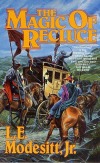
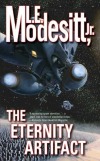
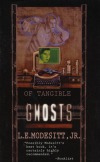
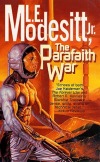
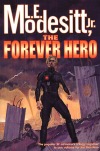


Great interview that actually tild me things I’d like tio know!
Thanks, Stefan. Long but not dull and meandering and boring!
Thanks Paul, I appreciate it. I was worried about the length of this post, almost split it into two sections, but then decided that fans of the author probably wouldn’t have an issue with its length. Lee was extremely gracious and patient throughout the process.
Thanks for the write-up Stefan. I’ve been meaning to read Modesitt for a long time and this may finally push me over the edge. I’m especially happy that his recommendations are there; now I know where to start.
I actually haven’t read all of the ones he recommends, so I can’t vouch for them (although given the overall quality of his works, I’m sure they’re great). My personal recommendations for newcomers are usually Archform: Beauty or The Parafaith War for his SF, and Imager for fantasy.
I should have waited for your reply before ordering his SF rec from the library. Oh well, I imagine I’ll get through all 50 of his books eventually.
Pingback: SF Tidbits for 5/23/12 - SF Signal – A Speculative Fiction Blog
Pingback: The Great Geek Manual » Geek Media Round-Up: May 23, 2012
Reblogged this on Misty Midwest Mossiness and commented:
Excellent interview with one of my long-time favorite fantasy authors, L.E. Modesitt, Jr.
Thanks for this interview. I love the Spellsong Cycle, it is a permanent feature on my bookshelf 🙂
I read the Magic of Recluse but somehow just couldn’t get into the Recluse Saga at all but I think I’ll have to check out Imager now.
Pingback: Geek Media Round-Up: May 24, 2012 – Grasping for the Wind
Pingback: The Week in Review « Tor/Forge's Blog
Pingback: The Eternity Artifact « Two Dudes in an Attic
Pingback: Talking With Tom: A Conversation Between Tom Doherty and L.E. Modesitt Jr. | Far Beyond Reality
Pingback: Imager, Imager’s Challenge and Imager’s Intrigue by L.E. Modesitt Jr. | Far Beyond Reality
Pingback: Scholar by L.E. Modesitt Jr. | Far Beyond Reality
Pingback: Imager’s Battalion by L.E. Modesitt Jr. (includes a giveaway!) | Far Beyond Reality
Pingback: Antiagon Fire by L.E. Modesitt Jr. (includes a giveaway!) | Far Beyond Reality
Pingback: Rex Regis by L.E. Modesitt Jr. | Far Beyond Reality